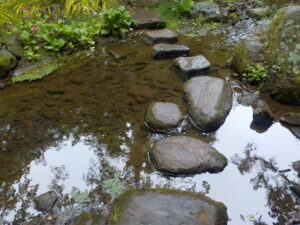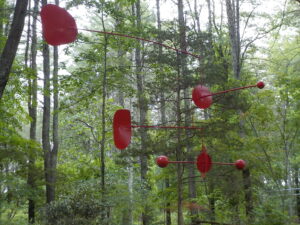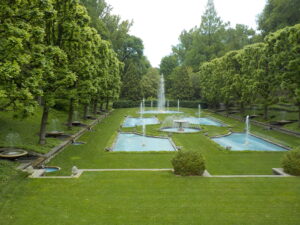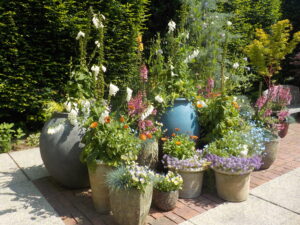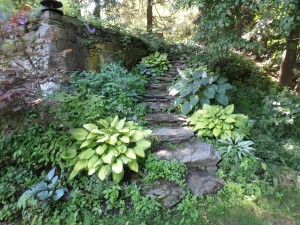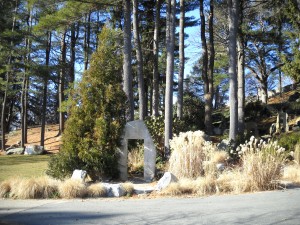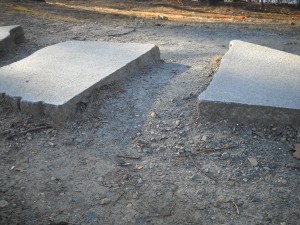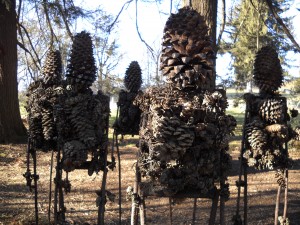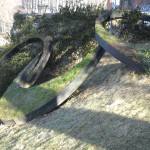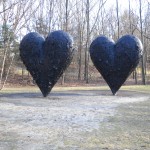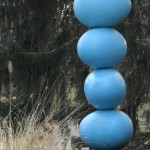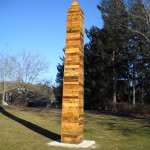Learning from Other Gardens
All these gardens had significant areas of lawn or meadow. I realize that lawns are not in favor, generally, among the pro-pollinator and bird crowd. But if you provide plenty of plants that support pollinators, I do not see lawns as bad. Each of these gardens has plenty of flowering trees, shrubs, perennials and annuals. Something is always in bloom, including both native plants and exotic ones.
Bedrock Garden only recently was deeded over from the original owners, Jill Nooney and Bob Munger, to the non-profit that manages the property. Jill is an amazing sculptor who for over 30 years has created art to surprise and delight visitors to this 20 acre garden. Much of her art is painted welded steel that will delight visitors for the century ahead. She is the modern Alexander Calder of gardens.
All three of the gardens I visited made much use of water in the landscape. I am lucky enough to have a small stream that runs by my gardens. I built a bench near it, so I can listen to the burble of the water. And you can tune your brook: Place stones that hold back water, allowing it to cascade over them. Different drops create different sounds.
Great gardens like those at Longwood, an old DuPont family residence originally, recognize that color is important all year. But most shrubs and perennials only bloom for a few weeks. So they choose trees and shrubs that are not only sculptural in form, but have also have nuanced colors in their leaves. Green is not one color, but many. Choose wisely.
How to Lead the Eye and the Visitor Through the Garden
Garden clubs often enliven the summer by asking members to open their gardens to members and friends for an afternoon. For some, this is a terrifying day – they fear people will criticize their design, notice the weeds, make fun of the garden whimsy. For others, open gardens are fun. People walk through, talking plants and sharing ideas about how to create special garden spaces with plants that are right for the terrain. Clearly the second group of gardeners have more fun.
There is a group of gardeners in Lyme, NH that encourages garden visits: they call their events, “Pardon My Garden”. They acknowledge that few of us ever have a “perfect” garden, no matter how hard we work or how many weeders we employ. My garden isn’t perfect? So what. Gimme some ideas. I love the concept.
But let’s say you wish to open your garden to a group, or just to have a garden party for a dozen close friends. How do you get people to move around and find the special places and plants you have, especially if you have a large space? I think that hardscape is the answer: paths, archways, arbors, pottery, sculpture, stonework and water all will attract the eye and draw a visitor forward. Let’s look at these.
The most ambitious is to create paths. Public gardens use them to keep the foot traffic from killing the grass, and to direct people through the gardens. Often the walkways are covered with gravel and edged with steel or aluminum strips buried vertically in the soil. These pieces of edging often come in 20 foot sections and are serious work to install. I’ve done it, but it’s not easy.
In home gardens, paths between beds and from one part of the garden to another generally are grass. Sometimes people put down ground bark or wood chips to define paths, though I prefer grass. And flat stones work well, too, for short paths.
The only trouble with stone paths is that it’s tough to mow around stones if they are raised up at all. So if you install flat stones, be sure to dig out enough soil so that your stones will be even with the ground and you can mow the spaces between and around the stones. Sure, you can use a string trimmer to do the job, but that is slower – and hard work.
Wooden archways and arbors invite visitors to pass through them – to see what’s on the other side. I have made them out of bentwood and out of cedar posts. I have grown clematis, scarlet runner beans and wisteria on them. All are lovely. One word of advice if you are custom-making an arbor: design it so that your lawnmower goes through easily. Or make one that will allow an adult and a Labrador retriever to go through together – even if you don’t have a dog. Four to five feet is good.
I recently weeded out a dry shady garden that has a nice piece of exposed ledge. I realized that I rarely noticed the ledge. I want visitors to pause and look at the unusual palette of plants I use in front of the ledge, too (now that the weeds are gone). What did I do? I moved a tall blue ceramic planter that I had on my shady deck down to the ledge. I have a vine with green and white leaves spilling out of the vase. It really brings the eye to that space.
If you have gardens on different levels, stone steps are great. Line them with plants that have interesting foliage that looks good all summer. People just want to walk up steps to see what is at the top (like the bear going over the mountain in that kids’ song). I put in steps a few years ago and they are a constant source of pleasure for me.
Fountains, pools, ponds, streams are good visual attractions, too. I am blessed with a natural stream, and find I am drawn to it daily. I keep the edges mowed so that weeds don’t obstruct the view.
Places to sit call out to visitors. I made a bench with a piece of white marble some years ago. Even though it is not a particularly comfortable place to sit (it’s hard, stone is cold, and it has no back) – it draws me across the lawn. It is enhanced by an umbrella plant (Darmera peltata) I planted in 2009 to honor my late sister. It is a dramatic plant: it has leaves 16 to 20 inches in diameter standing up nearly 4 feet tall.
My Adirondack chairs also beckon to me, and to visitors. I got wooden ones and painted them magenta. Even from a long distance, they stand out in contrast to the greens everywhere else. I gravitate towards them.
And ultimately, for gardeners, plants are the ultimate call. Have a magnolia in bloom? We all will walk to it. Roses? We want to sniff them – even if they are largely scentless, as most new roses are today. And even if your garden will never be on a gardentour, creating a draw will please you and your family.
Inspirations – deCordova Sculpture Park & Museum
January is generally an all-white month in my garden, though this year the snow has been off to a slow start. I love the curves of drifts, the smoothness of open spaces, the contrast between snow and the outlines of my trees, shrubs, arbors and stonework. Snow can create free sculpture in the garden – even without making snowmen.
In many gardens, however, winter is a boring time: without flowers, the garden is largely empty of interest. On a brilliant, blue-sky day I decided to visit an outdoor sculpture garden to enjoy a garden that is full of three-dimensional interest in winter. I wanted to see not only the sculpture, but the trees, shrubs and paths of the deCordova Sculpture Park and Museum in Lincoln, Massachusetts.
The deCordova was once the summer home of Julian de Cordova (1851-1945), a Jamaican by birth, who made his money as a tea broker and President of Union Glass Company. It is now offers a 35-acre sculpture park with 60 works of art, a museum (once his brick castle), a store, café and classroom space. When I visited, the museum was closed for the installation of a new show which opens January 22.
I spent about 3 hours looking at the outdoor sculpture and studying the landscape to see what I might be able to do on my own property – or that you might on yours. I am not an artist and have no budget for sculpture, but I had a great experience looking at contemporary sculpture of New England artists – the focus of the deCordova – and the landscape.
Leaving the parking lot on foot, I was immediately drawn to a glade of trees and shrubs that had a lovely collection of decorative grasses and a stone entrance created by cutting a doorway into large piece of granite. Any arbor or entry catches my eye, and draws me to – and through – it. Passing through this doorway, I ascended a gentle hill which had natural ledge exposed and other cut stone pieces added. Evergreen rhododendrons and tall pines provided texture and color. It was lovely.
At the top of the incline was an open lawn surrounded by majestic oaks and populated with large sculptures. I continued on, climbing a rocky hillside, following a pathway. Paths are great for moving visitors along, particularly in a multi-level landscape – I always want to move forward to see what lies ahead.
In the course of my visit I walked on several types of paths – gravel, grass, stone and pavement. The most interesting to me, and one that can easily be copied without having a big budget, was quite simple: an arrangement of stepping stones. By that I mean that the stones were not flush to the ground, but a few inches above it; each stone was anywhere from 18-48 inches in width and/or length. Due to the irregularity in size and shape, and the fact that each stone was separated from the next by 6-12 inches, the visitor is required to slow down and step carefully.
I’d never seen a stepping stone walk like this in a public space. It is not wheelchair accessible (though wheelchairs could travel on the hard-packed smooth lawn near the pathway), and it would be easy to trip and fall if not paying attention. Still, I liked the fact that I could not rush along it. If you have a garden with interesting small flowers, a stepping stone path would be one way to keep visitors moving through the garden slowly to see them – or your sculpture.
At the far end of one path was a 3-foot tall retaining wall on which visitors had made their own sculpture, which delighted me. The wall was decorated with small cairns – 3-6 small stones placed in a pile. I made one myself. Again, this is something you can easily do on your own landscape – now, in winter. You can see a short video of the cairns here:
httpv://www.youtube.com/watch?v=_pPkbBy73iE
In order for your cairn to survive, given the movement of the ground as it freezes and thaws, you need to build it on a stable base such as a stone wall. But if you accept that your stone sculpture may tumble down by spring, you can build one anywhere. I’ve seen cairns that are 3 feet or more feet tall but a nice collection of stones can be just a few inches. Place them carefully so that when you lightly touch the stones they don’t fall.
Sculptor Ronald Gonzalez created a site specific installation, a collection of human-like figures made of pine cones and steel. This is something that I could do, even though my artistic talents are (very) limited. He made simple stick figures of steel rebar, then attached (with wire) various sized cones to create heads and bodies. He created a tribe of them – a dozen or so – standing inside a circle of evergreen trees. I almost missed it when I walked by – but then let out a shout of glee when I saw it. Art? That’s for each viewer to say – but it was fun to see, and I might just create one – for winter interest.
So if your garden is flat and boring in winter, visit the deCordova to see what ideas you can bring home with you – and create something that will tickle your fancy and delight your eye next winter. See below some of the other sculptures at the deCordova:
Henry Homeyer is the author of four gardening books and writes a self-syndicated column on organic gardening that appears in 12 newspapers throughout New England. Henry’s Web site is www.Gardening-gGuy.com.



